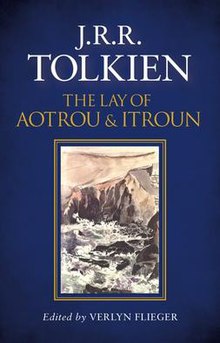The Lay of Aotrou and Itroun
 Front cover of the 2016 hardback edition | |
| Editor | Verlyn Flieger |
|---|---|
| Author | J.R.R. Tolkien |
| Language | English |
| Subject | Celtic mythology |
| Genre | Epic poetry |
| Published | 3 November 2016 (U.K.) |
| Publisher | HarperCollins Houghton Mifflin Harcourt |
| Publication place | United Kingdom |
| Media type | Print (hardback) |
| Pages | 128 |
| ISBN | 978-0008202132 |
| Preceded by | A Secret Vice |
| Followed by | Beren and Lúthien |
The Lay of Aotrou and Itroun is a poem of 508 lines, written by J. R. R. Tolkien in 1930 and published in Welsh Review in December, 1945.
Aotrou and Itroun are Breton words for "lord" and "lady". The poem is modelled on the genre of the "Breton lay" popular in Middle English literature of the 12th century, and it explores the conflict of heroic or chivalric values and Christianity, and their relation to the institution of marriage.
Sources
A major source for the poem has been identified as the Breton song 'Le Seigneur Nann et la Fee', which Tolkien probably knew through Wimberly's Folklore in the English and Scottish Ballads (1928).[1] Tolkien adds to his source a stern moral - repudiation of all traffic with the supernatural.[2]
Thematics
In the poem, Aotrou and Itroun are a couple of Breton nobility. They are childless, and Aotrou seeks the help of a witch. When Itroun is with child, the witch reappears, revealing herself as the Corrigan, and asks for Aotrou's love as payment. Aotrou sacrifices his knightly honour to Christian values, and breaks his word.
- "I gave no love. My love is wed;
- my wife now lieth in child-bed,
- and I curse the beast that cheated me
- and drew me to this dell to thee."
Cursed by the Corrigan to die in three days, Aotrou takes the consequences and places his trust in Providence:
- In three days I shall live at ease
- and die but when it God doth please
- in eld, or in some time to come
- in the brave wars of Christendom.
Aotrou died after three days, followed by his wife with a broken heart. They are buried together, and they do not live to see their offspring grow up - something that has been interpreted as a judgement on Aotrou for excessive family pride.[3]
Publication
The lay was originally published in The Welsh Review in 1945 but has been unavailable since. A book form, edited by Tolkien scholar Verlyn Flieger, is set to be published on 3 November 2016. Flieger also edited Tolkien's The Story of Kullervo (2015).
See also
References
Further reading
A. Lewis ed., Leaves from the Tree (London 1991)
T. Keightly, The Fairy Mythology (1878)

